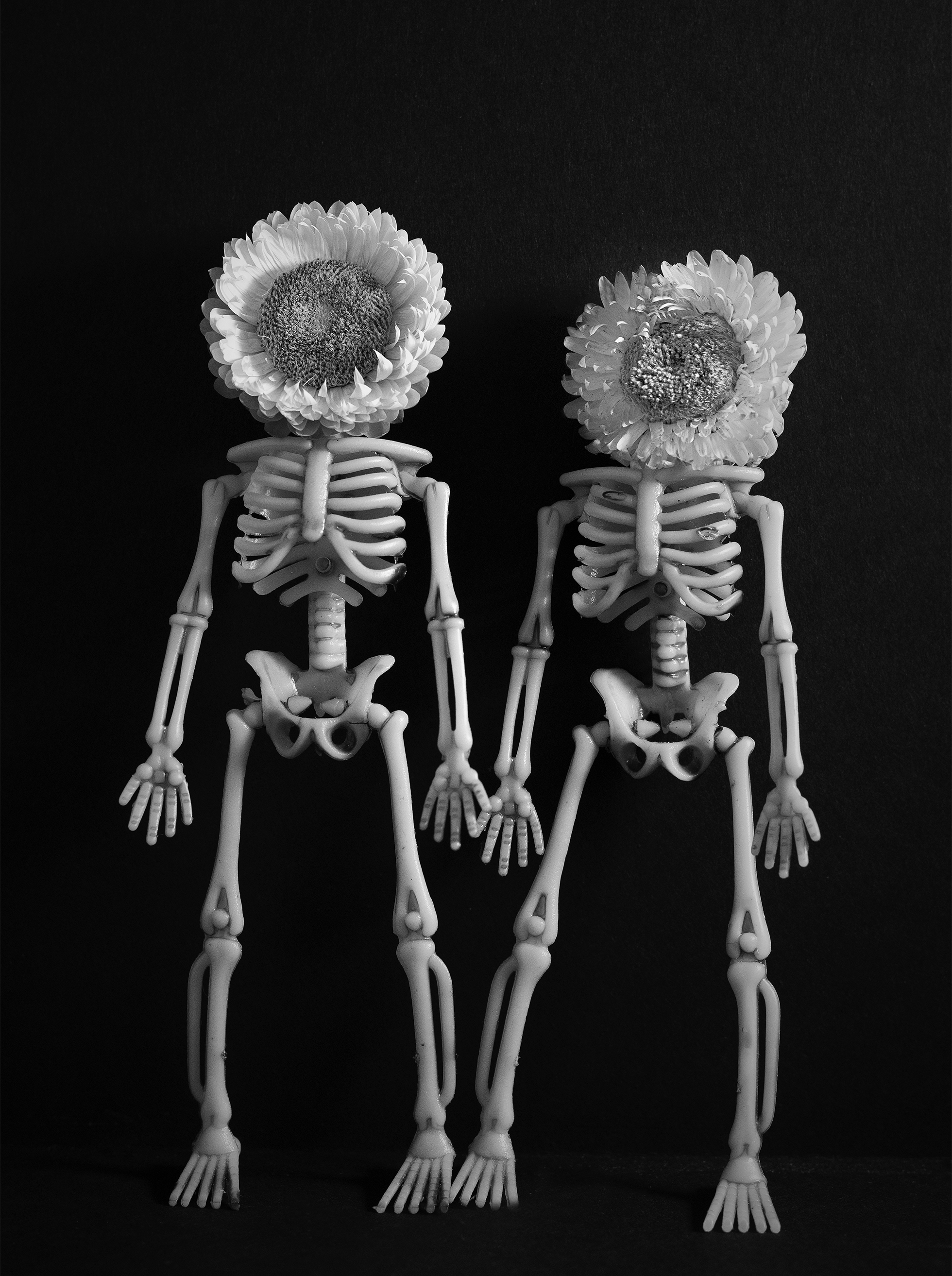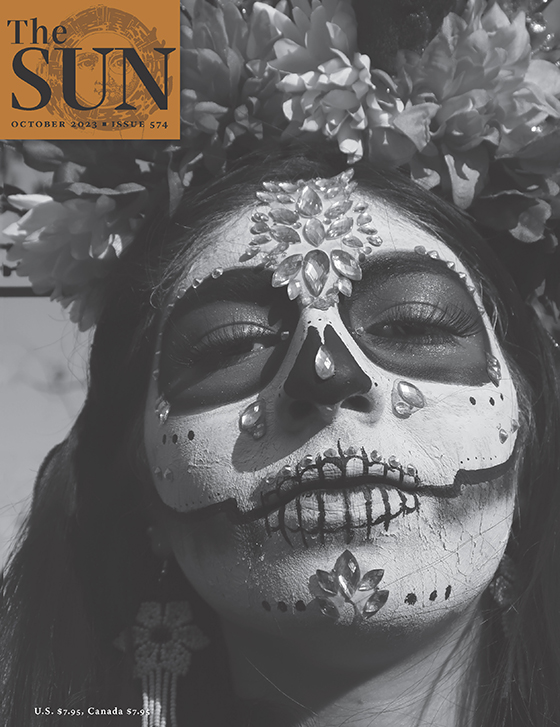In my New Jersey neighborhood it’s become kind of a thing for people to decorate their front lawns with skeletons year-round. On New Year’s they put little party hats on them, give them a champagne flute to hold. On Mardi Gras, beads draped around their necks, maybe a cigarette clamped in their jaws. Fourth of July, all kinds of red-white-and-blue regalia. During the long stretches between holidays, the skeletons rest. Most often in Adirondack chairs.
Maybe it’s like this all over the country. I don’t know. I just know what I’ve seen around here.
Though I have thought about putting skeletons on my own lawn, I’ve never done it. I think it would stress me out too much, trying to stay topical without doing the same bit as everyone else. Also, by the time I got around to considering it, lawn skeletons had become commonplace, and my contrarian defense mechanism kicked in: if other people were enjoying it, it probably wasn’t worth doing. A dumb way to think.
Our town is one of those idyllic, leafy suburbs you see in pharmaceutical commercials: an actress suffering from allergies — or irritable bowel syndrome, or suicidal depression — takes a pill and emerges from her fog to wander around smiling while kids fly kites in the park and men cook hot dogs over charcoal. Over the last two decades many of the smaller houses have been torn down or had ugly, hulking additions grafted onto them. There’s not as much room as there used to be for older couples, single people, or anyone trying to live modestly. Those buyers, my realtor tells me, have no options within a twenty-five-mile radius — at least, not until the next recession, assuming they don’t go broke along with everyone else. I know all neighborhoods evolve, but with each change here, more people are excluded.
As far as I know, the first house in the neighborhood to adopt a year-round skeleton display was a small Cape Cod a couple of blocks from me. The skeletons sat side by side, day after day, in their Adirondack chairs, holding hands as if starring in a Cialis commercial. The free hand of the wife skeleton — she wore a necklace and a blond wig — held a wineglass. The free hand of the husband skeleton — he wore a sun-faded, sleeveless Phillies T-shirt — gripped a can of Bud Light.
I walked past this house just about every day with my dog, and, after that dog died, I walked by it with my new dog. When that dog died, too, I swore I would never go through it all again — adopting and caring for and learning the quirks of and loving and eventually euthanizing a pet — but then we went ahead and got another dog. Every time my wife and I adopt one, friends say, “I knew you couldn’t do it.” Go without a dog, they mean. It’s nice having dogs around. I like hearing them snore while I’m writing. I like seeing their hopeful faces in the morning. Then, eventually, they die on you, and you have to be there for that, too. When the last one died, someone asked me if it ever gets any easier. The truth is it gets harder each time. The weight of it.
While walking my dog(s), I sometimes nodded to the skeletons as if they were the neighbors who lived in that house. I never saw the actual occupants. If not for the lights on upstairs and the two sensible Subarus in the driveway, I would have thought the house was vacant. On my walks I develop little bios for the inhabitants of the houses I pass, based on observations like the vehicles they drive, their bumper stickers and yard signs, the contents of their recycling bins. I know these surface clues tell only a small part of the story, but it helps to populate the world around me. I feel part of a community, one that exists mostly in my imagination.
Judging by the well-manicured lawn and the dated sunflower curtains in the front windows of the Cape Cod, I imagined the owners as an older couple. Once, I saw a cat lying in the window, and I thought, Yep, old folks. Not old old, but mid-fifties old. I was thirty-two then. There’d been a time when I’d thought thirty was old. I keep reassessing every five years or so. I’m forty-one now and don’t feel old yet. I feel like I know who I am, maybe for the first time in my life.
I imagined the husband as a man with a thick gray mustache, paint-spattered T-shirt tucked into baggy Wranglers, respectable beer belly spilling over his waistband. Twenty-five years as a general contractor behind him, dreams of a small place in Cape May where he could dock his fishing boat. A guy who might see me walking by in my Eagles hat and yell, Go, Birds! The wife I imagined working at the deli around the corner: taking orders, running the register. One of those indispensable people whose value you realize only after they’re not around. She was more than a little interested in the British Royal Family; he was the kind of guy who thought he had the commonsense solution to every problem. They’d grown up in the same neighborhood, orbited each other for a while, started dating, gotten married, bought a house down the road from the elementary school they’d both attended, three years apart. Had one daughter who was premed at Villanova but switched to psychology after a rough first semester, then went to grad school somewhere out west and developed an annoying habit of pathologizing everything. She thought the skeletons were morbid, possibly a sign of untreated depression, a cry for help from one or both parents. They assured her it was fine. It was funny. Not everything needs to mean something, they said.
When I was younger, I would have identified this couple’s life — my life — as a nightmare. Living a boring, safe suburban existence? I’d rather be dead. Would rather drown myself in the river. That’s the kind of thing I used to say. I was convinced that no one who inhabits such a life could honestly enjoy it. They were lying to themselves and everyone else. It was the lies, I thought, that kept them from losing their minds. On our honeymoon my wife asked me sincerely to stop making jokes about suicide. Until she said something, I hadn’t realized how often I did this, hadn’t considered how my dark attempts at humor might affect the people who would prefer me to be alive. I thought of myself as uncompromising back then, even as I made compromise after compromise. I envisioned a future in the arts, bumming around the world and smoking in dank bars while having deep conversations about books and philosophy. I’ve never smoked. I like hanging out with other writers only in small doses. (Why are we talking about books? There’s so much else happening.) I pretty much do have a life in the arts now, and there may be no other field that requires more-frequent compromises. But you don’t want to hear this kind of thing when you’re young.
One day, before the whole skeleton trend caught on, I walked by the Cape Cod and saw the wife’s chair was gone. The husband skeleton remained, right hand still clutching a beer, the other dangling empty. Though I feared the worst, I thought maybe the wife had been brought inside for repairs or a new wardrobe. The husband’s clothes hadn’t been changed to indicate mourning. (Though I thought: Maybe skeletons have a different perspective on this sort of thing.) Before long I had to acknowledge that the wife, the real wife, was dead: one morning, as my dog and I passed by, an elderly woman was knocking on the door, her husband standing behind her cradling two large trays of hoagies — the kind of delivery you make only after someone has died. About six months later I walked by and saw the husband skeleton’s head had fallen off. For a week it lay in the grass, mouth open in a grim smile. Then it was gone, and the chair was gone, too. I imagined the husband, maybe with his daughter’s help, packing both skeletons into a big Rubbermaid bin, which he would shove into a dark corner of the attic, to be rediscovered only upon his death. I imagined the two of them afterward, drinking tea at the kitchen table. The daughter had the good sense to skip the psychology talk and instead fill the air with stories about friends, restaurants, vacation plans.
Do I even have to tell you that I fear nothing more acutely than the loss of my wife? That, during the long stretches when she is at work and I’m at home alone, I sometimes wind myself halfway to a panic attack, wondering how I will survive if she never comes back? Suffice it to say, if you remove her from the equation, there’s actually not a whole lot to my life. I would get by, would adjust eventually. People survive worse all the time. But I would be a wreck for years.
I hated seeing that one chair on the lawn. I was glad when they put it away so I could stop thinking about it.
People are dying all the time. Since the skeletons disappeared, a few million have died from COVID, a few hundred thousand from flooding and famine, thousands from American gun violence. I’ve reached an age at which famous people from my youth have begun to die: Norm Macdonald, Kirstie Alley, Prince, Diego Maradona. My friends’ parents are dying. My wife and I are going to the funerals. My mom says she will live to be exactly seventy-eight: she’s done the math, though she won’t show us her work. If she’s right, that gives us five more years with her — twenty more than she got with her own mother, forty more than with her father. Between my wife and me, she’s the last parent we have left.
It was only after the wife skeleton disappeared that the trend took off in our neighborhood. Now you see a skeleton scene every three blocks or so. One yard has them sitting in a replica of a stagecoach. Another has them set up as if participating in a Survivor elimination ceremony. There’s one house, not far from the original, where the whole family, including the dog, is represented by skeletons. One January weekend a teenager robbed the deli across the street from that house, and the manager chased after him. The kid stabbed the manager eleven times and left him to die in the grass in front of that house. Afterward people left flowers and other mementos on the family’s lawn, right in front of the semicircle of skeletons, who stood with heads lowered, as if in mourning. Sometimes people laugh when I tell them about this, but it’s not a joke. None of it.





